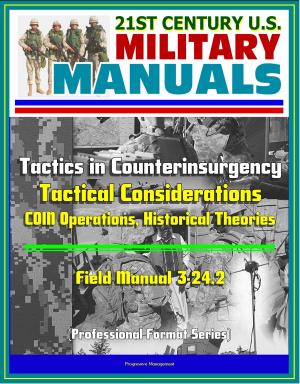Warden and the Air Corps Tactical School (ACTS): Deja Vu? The Enemy as a System and the Industrial Web Theory of Air Power Employment, Analysis of Contextual Factors, Instant Thunder Iraq Planning
Nonfiction, History, Military, Aviation| Author: | Progressive Management | ISBN: | 9781370704095 |
| Publisher: | Progressive Management | Publication: | September 27, 2016 |
| Imprint: | Smashwords Edition | Language: | English |
| Author: | Progressive Management |
| ISBN: | 9781370704095 |
| Publisher: | Progressive Management |
| Publication: | September 27, 2016 |
| Imprint: | Smashwords Edition |
| Language: | English |
This important report has been professionally converted for accurate flowing-text e-book format reproduction. This study answers the following questions: Is John A. Warden Ill's, "The Enemy as a System" analogous to the Air Corps Tactical School's (ACTS) industrial web theory of airpower employment? If so, why (given the 50 plus years between development of these theories)? If not, what are the prime sources of divergence? The author first describes both theories using an outline from which they are compared on an "apples to apples" basis. From this analysis, similarities and differences are presented. Next, the author discusses contextual factors affecting development of both theories. A baseline is developed from which factors from both eras are compared. After linking relevant contextual factors of the 1920s-'30s and 1980s-'90s, the author explains why the theories of ACTS and Warden are more similar than different. Finally, implications are drawn from the preceding analysis to address the issue of how airpower theory should be developed.
In the 1930s, faculty members at the Air Corps Tactical School (ACTS) developed the industrial web theory, a concept of strategic air operations to guide the employment of American airpower. The most important enunciation of the industrial web theory came in August 1941. Several key instructors had been reassigned from ACTS to the Air War Plans Division (AWPD) in Washington. The division wrote into the basic war plan— AWPD-1, "Munitions Requirements of the Army Air Force"—their "longstanding faith in precision bombing." AWPD-1 planned to apply airpower "for the breakdown of the industrial and economic structure of Germany by destroying a system of objectives vital to the German war effort: primarily power, transportation, and oil industries." World War II air planning would be built on the foundation of AWPD-1. Though the Pacific theater was omitted from this document, "a strategic air offensive based on precision-bombing doctrine was written into official policy."
Fifty years later, in 1991, Col John A. Warden III and his Pentagon staff developed an airpower plan to defeat Iraq. Called Instant Thunder, the plan identified electricity, retail petroleum, and weapons of mass destruction as centers of gravity. Colonel Warden insisted that destruction of these centers of gravity would render Iraqi leadership unable to resist United States (US) policy. Instant Thunder became part of a four-phased plan of operations for Operation Desert Storm. In 1995 Warden's theory, the basis of Instant Thunder, was published. In his last active duty assignment, Colonel Warden served as commandant of the Air Command and Staff College. He remains a central, modern airpower theorist.
This important report has been professionally converted for accurate flowing-text e-book format reproduction. This study answers the following questions: Is John A. Warden Ill's, "The Enemy as a System" analogous to the Air Corps Tactical School's (ACTS) industrial web theory of airpower employment? If so, why (given the 50 plus years between development of these theories)? If not, what are the prime sources of divergence? The author first describes both theories using an outline from which they are compared on an "apples to apples" basis. From this analysis, similarities and differences are presented. Next, the author discusses contextual factors affecting development of both theories. A baseline is developed from which factors from both eras are compared. After linking relevant contextual factors of the 1920s-'30s and 1980s-'90s, the author explains why the theories of ACTS and Warden are more similar than different. Finally, implications are drawn from the preceding analysis to address the issue of how airpower theory should be developed.
In the 1930s, faculty members at the Air Corps Tactical School (ACTS) developed the industrial web theory, a concept of strategic air operations to guide the employment of American airpower. The most important enunciation of the industrial web theory came in August 1941. Several key instructors had been reassigned from ACTS to the Air War Plans Division (AWPD) in Washington. The division wrote into the basic war plan— AWPD-1, "Munitions Requirements of the Army Air Force"—their "longstanding faith in precision bombing." AWPD-1 planned to apply airpower "for the breakdown of the industrial and economic structure of Germany by destroying a system of objectives vital to the German war effort: primarily power, transportation, and oil industries." World War II air planning would be built on the foundation of AWPD-1. Though the Pacific theater was omitted from this document, "a strategic air offensive based on precision-bombing doctrine was written into official policy."
Fifty years later, in 1991, Col John A. Warden III and his Pentagon staff developed an airpower plan to defeat Iraq. Called Instant Thunder, the plan identified electricity, retail petroleum, and weapons of mass destruction as centers of gravity. Colonel Warden insisted that destruction of these centers of gravity would render Iraqi leadership unable to resist United States (US) policy. Instant Thunder became part of a four-phased plan of operations for Operation Desert Storm. In 1995 Warden's theory, the basis of Instant Thunder, was published. In his last active duty assignment, Colonel Warden served as commandant of the Air Command and Staff College. He remains a central, modern airpower theorist.















